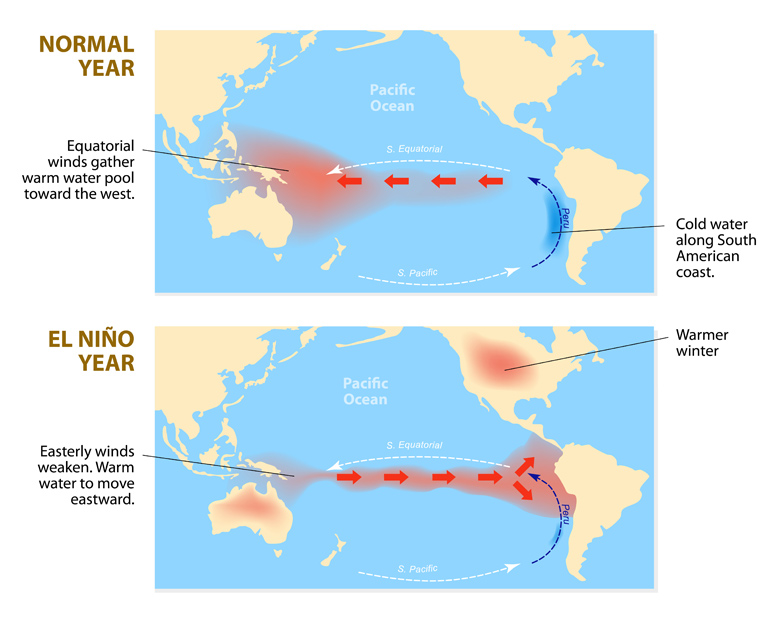
14th May 2015 "Substantial" El Niño predicted for 2015 The Australian Government's Bureau of Meteorology has confirmed that the tropical Pacific is in the early stages of an El Niño that is likely to persist in the coming months.
The tropical Pacific is now in the early stages of an El Niño. Based upon the model outlooks and current observations, the Bureau's ENSO Tracker has been raised to El Niño status. El Niño–Southern Oscillation (ENSO) indicators have shown a steady trend towards El Niño levels since the start of the year. Sea surface temperatures in the tropical Pacific Ocean have exceeded El Niño thresholds for the past month, supported by warmer-than-average waters below the surface. Trade winds have remained consistently weaker than average since the start of the year, cloudiness at the Date Line has increased and the Southern Oscillation Index (SOI) has remained negative for several months. These indicators suggest the tropical Pacific Ocean and atmosphere have started to couple and reinforce each other, indicating El Niño is likely to persist in the coming months. Pacific Ocean temperatures are likely to remain above El Niño thresholds through the coming southern winter and at least into spring. "This is a proper El Niño effect – not a weak one," David Jones, manager of climate monitoring and prediction, told reporters. "You know, there's always a little bit of doubt when it comes to intensity forecasts, but across the models as a whole we'd suggest that this will be quite a substantial El Niño event." The last El Niño was observed during 2009–10. A very strong El Niño has not occurred since 1997–98. It was during 1998 that global average temperatures spiked to an unprecedented high. Since then, average temperatures have continued to rise, with 2014 being the hottest year on record even in the absence of significant El Niño conditions. According to Jones, this means there is a "significant probability" that 2015 will top 2014 as the hottest year globally. Seven of the ten warmest years occurred during El Niño years. "The most obvious thing we know is that El Niño events tend to lead to drier winter and spring periods [in Australia]," Jones explained. "There is an increased risk of drought, which obviously isn’t good for people already in drought. Australian temperatures are already warming – and El Niño tends to give those temperatures a boost – so we’d expect winter, spring and even early summer to have well above average daytime temperatures." Australia is among the regions most dramatically affected by the recurring weather phenomenon, but its effects are felt around the world. South America is hit by heavy rains and floods, while the USA experiences warmer winters. In Africa and parts of Asia, scorching temperatures can lead to rises in the price of commodities such as rice, corn and palm oil. Additional health and social impacts include the increased spread of diseases, especially those which are transmitted by mosquitoes. In Europe, the snowy UK winter of 2009–10 was thought to be an effect of El Niño. In general, developing countries dependent upon agriculture and fishing, particularly those bordering the Pacific Ocean, are likely to be worst affected. Research by Columbia University suggests that ENSO may have had a role in 21% of all civil conflicts since 1950, with the risk of annual civil conflict doubling from 3% to 6% in countries affected by ENSO during El Niño years, relative to La Niña years. During the last several decades, the frequency and intensity of El Niño events has increased. This is most likely linked to global warming and the increasing level of greenhouse gases in the atmosphere – although a longer period of observation is needed to confirm this. Scientists have theorised that permanent El Niño conditions may emerge when global average temperatures increase by 3°C (5.4°F).
Comments »
|







